When anyone official trots out the phrase “barrier to something or other” they are generally trying to blame the rest of us for not doing what we ought to be doing, and threatening to unburden us of said obstacle for our own good. A “barrier to work” means “get off your arse you lazy tosser else we are taking your benefits away” and a “barrier to healthy eating” translates as “oi, lard arse, we are taxing those pies if you don’t lose a few pounds you useless burden on the state!”
So, I’m naturally sceptical when there’s talk about “barriers to walking”. I expect to be accused of not making enough effort to skip across my recommended quota of zebra crossings, and live in fear of the authorities beating down my door in a 4am raid to confiscate any inappropriate footwear. What the heck could a “barrier to walking” possibly be anyhow?
There are plenty of literal barriers about. I hadn’t really noticed how many of them there are in Leeds city centre until the other day when I was having a “barriers to walking” conversation with a friend in the pub.
“Why don’t people walk more? What’s stopping them?” I asked, swirling the dregs of wine and pondering the next bottle.
“What are the barriers to walking, you mean” she said.
I looked out of the window. “Like that?” I said, pointing to an expanse of rigid, grey, unappealing metal stretching down the edge of a pavement. “That looks like it could stop a herd of stampeding wildebeest.”
“Those traffic barriers are there to keep pedestrians safe” she said. “Look at how fast the cars are going, you’d stand no chance if there was an accident …”
I’ve been thinking about this for a couple of days now. On the surface it does seem to make sense. And by the look of many of these barriers it’s obvious that if a car can do that much damage to tempered steel then flesh and bone wouldn’t stand much of a chance. So, yes, safety is always first, no one is going to challenge that idea.
But look at these photos. They were taken late afternoon in what is the new “Arts Quarter”. BBC, West Yorkshire Playhouse, Northern Ballet, Munro House – you’ve only got to whisper “architect”, “animator” or “actor” around here and there’s a noisy rabble within seconds wanting to give you their elevator pitch. To use the Leeds marketing buzzword of the moment, the place is about as “vibrant” as it gets.
Behind the traffic barrier there is perfect safety. The pavements are wide and well made and pleasant enough. But they are safe because they are mostly empty (and when it comes to traffic planning the safest street is the one that nobody ever uses.)
So, I have a question. Do we actually need the barriers? Don’t they just encourage drivers to speed, assuming if they have an accident the pedestrians will be protected by a shield of steel? And don’t they simply discourage the rest of us from walking and occupying public space? Because they are so ugly, inhuman and nasty? Can’t we imagine a shared solution where we could have an attractive street which would be good to walk along but still could be reasonably efficient for through traffic?
How could we redesign the street so it works for everyone?
Come along to our Walk on the Leeds side event about making walking in the city better for everyone, at The Belgrave Music Hall, November 6, 5.30-8
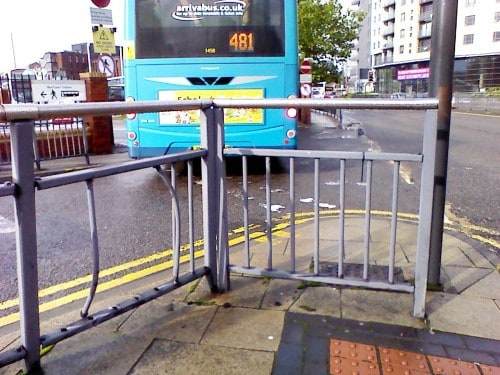
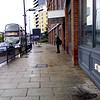
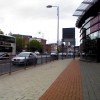
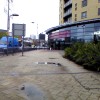
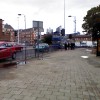
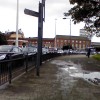
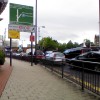
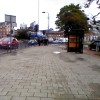
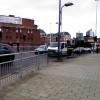
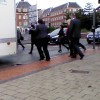
I think I can I answer the general question rather than the specific. I walk to work a couple of days a week from South Leeds. It is about 2 1/2 miles and I enjoy it, so why don’t others?
– Time. It takes me about 40 minutes, by the time I’ve walked to the bus stop and waited for a bus plus the bus journey time, it also takes about 40 minutes :-). To be fair I’ve long legs and it probably takes others a bit longer but the health benefits of walking 5 miles a day make it worth it.
– Weather. No such thing as bad weather, only the wrong clothes. Ironically, I started walking when the snow and ice made other transport difficult.
– Safety. I think this is the real one, people don’t always feel safe, especially as a walk from South Leeds down Beeston Road will take you past a number of boarded up buildings.
Of course the more people out and about the safer the streets are. For example Halloween feels surprisingly safe early evening as there are so many families on the streets nowadays.
I did wonder if Adult “walking buses” might be the answer. Walk to work club leaving Beeston Co-op at 8am for City Square by 8.45 anyone?
ps, if you see a tall grumpy looking bloke in a suit striding down Beeston Road on a morning feel free to say hi.
Like the idea of the walking bus. Did more or less the same route into town for ages – from Beeston Hill, so slightly shorter travel times.
What would make the streets safer do you think? Is it just getting more people out and about?
And the walk from Beeston into town is hardly attractive. The “doughnut of despair” between the old Junction Pub/Holbeck flyover and town is dreadful when it’s dark (and possibly worse in the day when you can see the full horror.) I can totally understand why people don’t want to walk that way.
PS if you see a tall, grumpy, purblind bloke (not in a suit) wandering in Beeston do yell … I’ll never see you!
I am convinced it is purely about having people around in urban environments that makes people feel safe.
Leeds on Light Night feels a different place, crowded, vibrant, more friendly.
I think Cross Flatts Park has begun to feel safer now it is used more, certainly in the day and on summer weekends when there is usually at least one game of cricket being played.
It’s a little known fact that guardrail was originally put in place to stop cars parking on busy streets…
https://www.google.co.uk/url?sa=t&source=web&cd=1&cad=rja&ved=0CC8QtwIwAA&url=http%3A%2F%2Fm.youtube.com%2Fwatch%3Fv%3D2xcpe0IfwNY%26desktop_uri%3D%252Fwatch%253Fv%253D2xcpe0IfwNY&ei=hW5xUpTkHKm30QX8roD4Aw&usg=AFQjCNEQ2OlC5SvfgOzlOzT_eoWnpqhFsw&bvm=bv.55617003,d.d2k
I’d scrap all the fences along the city centre roads. They’re not just generally ugly, but also hamper the free flow of pedestrian traffic along pavements that are often very narrow to begin with. They also suggest that the powers-that-be don’t trust us to negotiate our way around town safely without such corralling. In fact, some years ago there was a report on Newsnight (I think) about town centre roads on which a town planner from Denmark commented as such: that the authorities were treating us like children who can’t be trusted to cross the road.
Was it Hans Monderman? His party trick was to get interviewed on live tv next to one of his shared space road junctions and walk backwards out into oncoming traffic … some good stuff on youtube.
I can’t remember who it was. But I’ll check-out the Youtube stuff.
It’s good to see this getting talked about in Leeds – although I can’t make it to the event.
I get around Leeds mostly cycling and walking and I love getting around Leeds that way. However far too often it’s not that pleasant and the problem is an obvious one – too much traffic. The noise, the fumes, and the way many of our roads, junctions, traffic light sequences etc are set up prioritise cars over people on foot.
I’m not daft, I know we’ve got to keep traffic flowing but it’d be interesting to think what we could do to make thing more pleasant for people on foot. I’m interested in particular in looking at how traffic lights are programmed. I understand that it’s complicated at busy junctions, but I don’t understand why often I have to wait what feels like far too long to cross a road at a pedestrian crossing. Who programmes them? On what basis? And could they be programmed to give pedestrians greater priority, so we don’t have to wait so long?
At the same time, it’d be worth looking at the amount of time given to people crossing. Recent research http://www.ucl.ac.uk/news/news-articles/1206/14062012-Most-older-people-unable-to-cross-roads-in-time suggests this is a particular issue for older people. My experience in Leeds is that too many pedestrian crossings don’t give you enough time – particularly if someone runs the red light or if you decide to wait until you’re sure that the driver has seen the red light.
Rob
The worst ones I know are opposite Bewleys Hotel. 3 lanes of traffic, 7 seconds to cross. I’ve seen older people in the middle lane as lights turn green terrified as cars start to move forward, to save a second or two to three next stop light.
Btw, do you think pressing the light at a pelican crossing makes any difference to how long you have to wait?
I think as this article suggests, it depends http://www.bbc.co.uk/news/magazine-23869955
I can see how it’s complicated at junctions, but I don’t see why more can’t be done at other crossings to give people on foot greater priority. And more time. Some junctions where you need to cross 2 roads can take forever to navigate because the crossing time is so short and you have to wait for two sequences. Do you reckon through #walkleeds we can explore this stuff more? Is it Highways that decide on crossing times etc? On what basis?
I couldn’t make it to the Walk on the Leeds side event last week, but I’m very interested in the subject. The barriers to walking in the city and, also I think, the legibility of the city for pedestrians, needs major attention.
Rob, yes it is Highways that determine the crossing times, which have to fit with the phasing of the lights at junctions, and no doubt it is a matter of complex timing issues and attempts to reconcile pedestrian and vehicle needs. That’s not to say though that issues cannot be improved by Highways if brought to their attention (he said optimistically).
There is a pedestrian crossing on the Calls, across the loop road between 42 The Calls hotel and Shears Yard restaurant, where the response time for the lights to go to red after pressing the button is almost nil – the priority is heavily biased towards the pedestrian (although there is a built in reset time to prevent gridlock). Admittedly this is a simple example – there is no junction involved – but it shows that the pedestrian can be favoured if the walking experience is prioritised.
Personally, I would love to see some trials in Leeds around the potential for removing barriers and traffic lights. It sounds counter-intuitive, particularly to parents with children, but look at the example of Poynton in Cheshire for a way to deal with a busy, complex junction – http://www.youtube.com/watch?v=-vzDDMzq7d0
The idea of shared space is being implemented by council’s with enlightened highways depts (see Coventry example – http://www.bbc.co.uk/news/uk-england-coventry-warwickshire-19816814) – wouldn’t it be gret to see Leeds going down this path also?